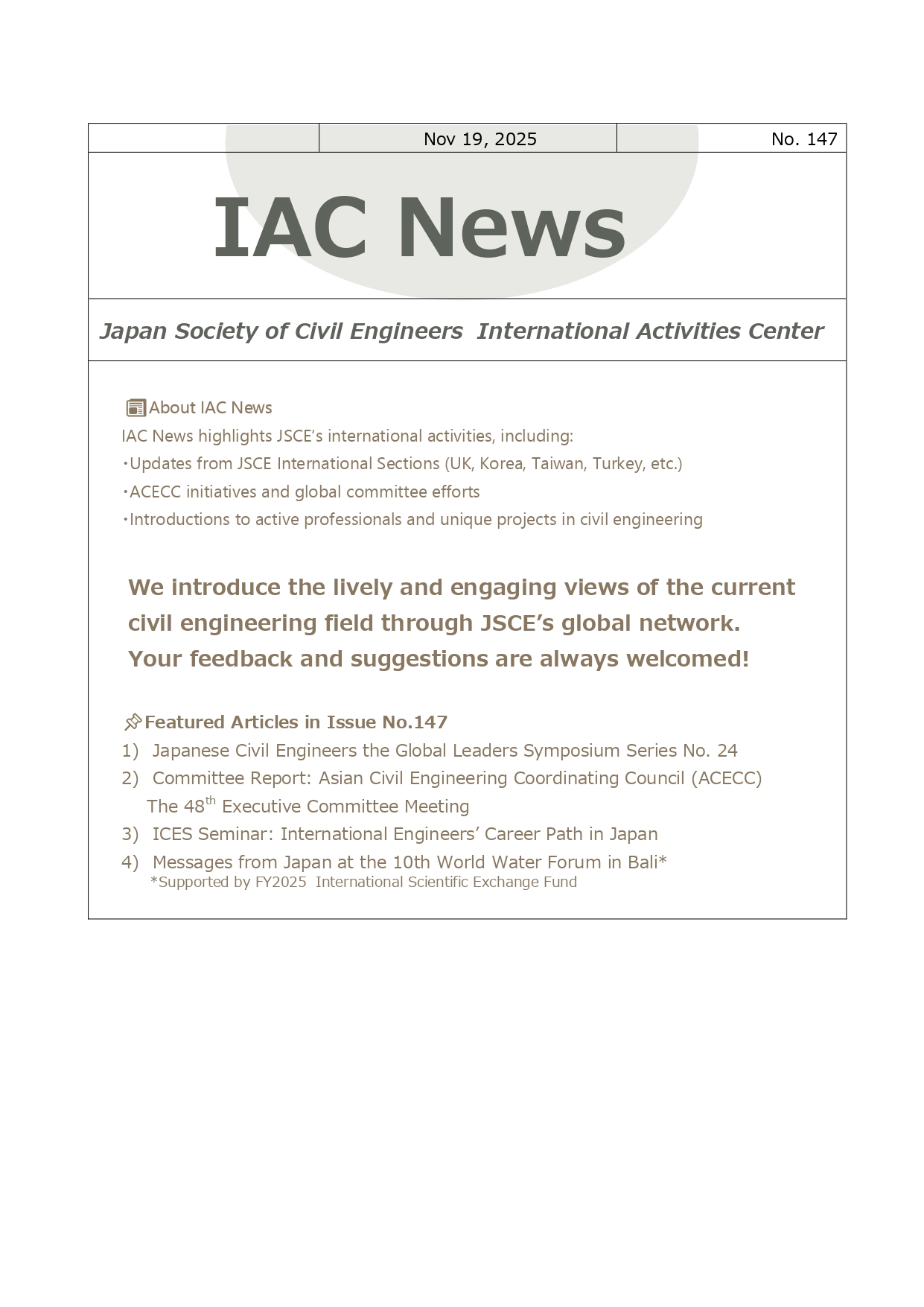IAC News
Newsletter No. 37, April 2012
Flash Report of The Great East Japan Earthquake
Briefing Report of the JSCE 2011 Great East Japan Earthquake Commemorative Symposium in March
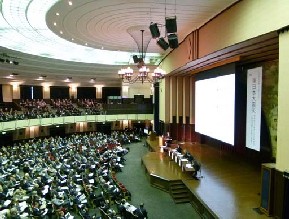
Reported by Motoki KAZAMA, Professor, Tohoku University, Secretary General of the Special Committee on the Great East Japan Earthquake, JSCE
On March 5-6, 2012, almost one year after the occurrence of the Great East Japan Earthquake, a symposium entitled “One Year after the Quake and Future – Large-Scale Natural Disaster Mitigation, Preparedness, Response and Recovery –” was held at the Hongo Campus of the University of Tokyo.
In the beginning, Mr. Naoyoshi SATO, Administrative Vice Minister of the Ministry of Land, Infrastructure, Transport and Tourism, gave an opening address.In Part I on March 5, as a project aimed for not only engineers but also general citizens widely from the perspective of civil engineering, we had Mr. Goro KOIDE, former NHK commentator, deliver a lecture entitled “Civil Engineering beyond the Turning Point’”. Following this, in a panel discussion entitled “What Lessons Have We Learned from 2011 Great East Japan Earthquake?” (Coordinator, below shown as CN: Takuro YAMAMOTO, JSCE President), raised issues brought up by the disaster in terms of social security and restoration with the perspectives of national land planning and politics and economics.
In Plenary Session I in the afternoon entitled “Questioning the Basic Stance Facing Massive Natural Disaster” (CN: Kiyoshi KOBAYASHI, Professor, Kyoto University), Prof. Carlos Sousa OLIBEIRA, President, Portuguese Society for Earthquake Engineering, introduced their experience of recovery from the 1755 Lisbon Earthquake. Prof. J. C. CHERN, Professor, National Taiwan University, Minister of Public Construction Commission of Executive Yuan, Taiwan, introduced their efforts for recovery from Typhoon Morakot.
Message from JSCE President
Message of JSCE Presidentin JSCE Magazine of January, 2012
2011 New Year’s Greeting by JSCE President JSCE International Strategies Shift into Full Swing (JSCE Magazine of January, 2012)
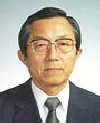 YAMAMOTO Takuro JSCE 99th President
YAMAMOTO Takuro JSCE 99th President
At the beginning of the year of 2012, I would like to make a cordial New Year’s greeting to all the JSCE members and all the people of Japan. Following the turbulent year of 2011, JSCE is determined to make continuous efforts gathering all our wisdom and expertise for recovery from the Great East Japan Earthquake as well as for preparation for a mega earthquake which is assumed to occur in the future. I would like to ask for your continuous cooperation.
In the preface of the January issue, let me take up a subject of international strategies, which is a difficult issue to address among a lot of matters of concern that our society has. I think that we must forcefully advance international strategies of civil engineering world, and that JSCE should play the central role, which have already been discussed well enough. Since the 2011 May and June issues of this magazine featured this theme, I would like to talk about our further efforts. Then I would like to make a proposal that we strengthen the system for implementation of overseas strategies, clarify the issues that we need to address as soon as possible, and aim at carrying them out.
Looking back over the international strategies of JSCE in the past, “Series - International Strategies of Civil Engineering World”, which was a separate volume compiled from the series featuring projects of the JSCE magazine, was published in 1998. In it, a sense of crisis about the international strategies of civil engineering at that time was highlighted, and especially, Dr. Patricia Galloway, Director of the ASCE International Division at that time, stated very kindly what we should do in her paper entitled “JSCE’s Crisis”, and we realize that it holds true even now. Subsequently, in 2007, we had the President’s proposal “Contribution to Asia” and other plans featuring internationalization, but we still have a lot of serious issues left unsolved.
Under such circumstances, JSCE has been stepping up efforts in our international activities, besides academic exchange activities by the JSCE International Activities Committee, other research committees and by individual members, activities for the Asian Civil Engineering Coordinating Council(ACECC) as well as other societies/institutions under Agreement of Cooperation and overseas chapters. However, those activities are respectively independent, and it is the current state that unification of information and organizational activities such as enhancing transmission to overseas is insufficient and difficult to be seen from outside. In order to make a breakthrough of such circumstances, JSCE set up the Committee on Civil Engineering Internationalization Strategy (Chair: Shigeru MORICHI, Professor, National Graduate Institute for Policy Studies) and is in the process of reorganizing medium and long-term assignments as well as expediting materialization of the issues we should address as quickly as possible.
What I keenly feel is, despite the fact that we are saddled with a mountain of important issues concerning international strategies, that our organization is not strong enough or not well prepared to address them. What we should do is already clear from the past long years of discussions, and it is our urgent issue to put in place a system for implementation. However, since the activities of our society are only possible under cooperation of the members who have busy business of their own, if the secretariat system is week, the activities are restricted greatly. At present, only a few staff members of the International Affairs Division are handling various duties but it’s almost reaching a limit. Measures to strengthen the organization and establish a system of a top leader’s management on a full-time basis must be taken as soon as possible. These strengthening measures have rarely been implemented because of various restrictions such as securing human resources and financial problems. Furthermore, financial situation is becoming more and more difficult as taken up in the President’s message in the December issue. However, considering the severe circumstances of civil engineering world, it is no time to hesitate further. All the relevant people’s understanding and cooperation would be strongly requested.
In Plenary Session II in the afternoon entitled “Planning Effective Actions Toward Strengthening the Disaster Response Capability of the Society” (CN: Kyuichi MARUYAMA, Professor, Nagaoka University of Technology), specific measures toward the future were discussed. Ms. Lesley Carol EWING participated in the session from California Coastal Engineering Committee, ASCE, and introduced the lessons they learned from their investigation. On Day1, approximately 1,000 people participated and the Yasuda Hall of the University of Tokyo was totally full. Also there were many participants of general citizens, which proved that general citizens were highly interested in this issue.
In Part 2 on March 6, topics with high expertise were discussed centering on the activities done by the Special Committee on the Great East Japan Earthquake of JSCE targeted to professional civil engineers. In the session “Characteristics of 2011 Great East Japan Earthquake and Tsunami, and Recovery and Reconstruction” (CN: Koji FUJIMA, Professor, National Defense Academy of Japan), we had Dr. Subandono DIPOSPTONO (Director for Coastal and Ocean Affairs, Ministry of Marine Affairs and Fisheries, Indonesia) as a researcher, engineer and administrator in a foreign country that was involved in a mega disaster. In the session “Recovery and Rehabilitation Plans for the Affected Areas: Present Status, Challenges and Future Vision” (CN: Takayuki KISHII, Professor, Nihon University), we had Mr. Alex Kwok-Kuen TAN (L & T Consulting Inc., ASCE). In the session “Lessons Learned from the Soil Liquefaction Caused by the Earthquake” (CN: Ikuo TOWHATA, Professor, The University of Tokyo), we invited Prof. Misko CUBRINOVSKI (Professor, University of Canterbury, New Zealand). In any session, the room was mostly full and eager questions and answers were exchanged. The total number of participants on Day2 was approximately 700. For the detailed report of the sessions, please refer to the JSCE website.
Disaster Report
Summary of 2011 Eastern Turkey Earthquakes Report, “Site Investigation and Engineering Evaluation of the Van Earthquakes of October 23 and November 9, 2011”
An earthquake (Van-Erciş earthquake) with a moment magnitude (Mw) of 7.2 and a local magnitude of 6.7 occurred at 13:41 on local time on October 23, 2011 in the Van province located in the eastern Turkey. The major energy release occurred within 20 seconds although the total duration of the rupture was about 50 seconds. According to the official report, the casualties are 604 and the number of injured people is more than 4000, which were caused by collapsed or damaged residential and commercial buildings. A number of buildings collapsed particularly in Erciş town (about 60 buildings) and Van (one building). In this earthquake, liquefaction and associated ground deformations were evident and wide spread sand boils were observed particularly in Erciş Plain and the flood plain of Karasu River at the north of Van city.
17 days after the Van-Erciş earthquake, the region was also hit by another earthquake with a magnitude of 5.6 (Mw) on November 9, 2011 at 19:23 on local time. Because the epicenter of this earthquake is located near Edremit, which is a town on the eastern shore of Van Lake about 16 km to the south of Van city centre, the earthquake is called Van-Edremit earthquake. This earthquake caused the collapse of 25 buildings in Van city centre. Fortunately, 23 of them had been evacuated due to previous damage occurred in October 23, 2011 earthquake. The total dead loss and injured people caused by this earthquake are 40 and 30, respectively. This earthquake also caused additional damage to some buildings and liquefaction.
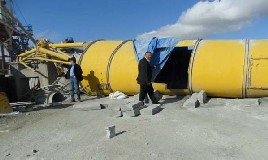 Photo Collapsed cement silo in the Van Industrial complex (KOERI, 2011)
Photo Collapsed cement silo in the Van Industrial complex (KOERI, 2011)
In this report, site observations carried out throughout the earthquake region and information gathered by the authors are described. This study is an inter-disciplinary work of various disciplines of science and engineering such as geology, seismology, tectonics, and geotechnical and earthquake engineering. This investigation was carried out to cover both engineering and scientific aspects of both earthquakes. In addition to the observations, evaluations and possible causes of the damages, and recommendations for future earthquakes and lessons learned from these earthquakes are presented in the report.
Aydan Omer, Professor, Tokai Univ.
Member of Earthquake Engneering Committee
*You can download the report from following website: http://committees.jsce.or.jp/disaster/earthquakes/20111023_turkey_eq
Linkage Student Program Report
Linkage Double Degree Master Program between Indonesian University and Japanese University (Linkage Program)
The Linkage Program started in Oct. 2007 as Japanese ODA Scholarship Loan (Yen Loan) Program to Indonesia. The purpose of the Linkage Program is to strengthen the professional capacity of Indonesian government officers at the central and local levels to facilitate the decentralization policy and foster on-going process of local autonomy.
The Linkage Program is schemed in such a way that the Indonesian graduate students (approximately 100 students per annum for 5 to 7 years) study at the Indonesia’s graduate schools for the first year and are sent to the Japanese graduate schools to complete the second-year studies in Japan. Those who successfully complete the second-year studies in Japan can obtain 2 Master’s Degrees from Japan and Indonesia. 5 Indonesian top universities and 11 Japanese universities have taken part in the Linkage Program.
The Graduate School of International Cooperation Studies, Takushoku University, has been accepting about one dozen students every year from three universities; Gajah Mada University, Brawijaya University and Padjadjaran University. Needless to say, all the courses are taught in English and Master’s thesis is written in English in Japan.
A few of the fifth batch students are introduced hereunder.
Koji Fujimoto
Professor, Takushoku University
Linkage Program Student Report (1)-Research on Providing Basic Infrastructure through Participatory Development in Rural District of Indonesia
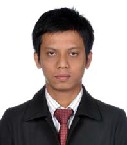
I have been working as government employee since 2005 at Community Empowerment Agency of Batang Local Government of Indonesia. Batang is an Indonesian district located on north coast of Central Java Province. My main task, as a staff at Village Development and Poverty Reduction section, is to facilitate the team on planning, monitoring, and evaluating for poverty reduction programs. Most of my tasks are related with National Community Empowerment Program in Rural Area (PNPM Rural) activities since my office is the implementing agent of this program at district level. I am involved in proposing project locations to central government, monitoring program implementation in the villages, up to evaluating and reporting the program.
Based on my experience at the field, even though PNPM Rural is an open menu program meaning that villagers can choose numerous activities encompassing rural infrastructure, capacity building, education, and micro credit activities, but in fact over 80 percent of village proposals are related to basic infrastructure such as road hardening or asphalting, building a bridge, water channel, irrigation system, school building, integrated health service post and so on. It can be assumed that the major village needs is basic infrastructures, and this is in line with the objective of PNPM Rural to provide basic infrastructure in rural areas through participatory approach.
In participatory development the communities are involved in the planning phase, project selection, and the evaluation phase. The involvement of the community in the development process becomes an essential component. Through this approach, the community will have a sense of ownership and voluntarily cooperate with the program while at the same time benefiting from it.
Having the opportunity to study in Japan under the Linkage Master Program of the Professional Human Resources Development Project, a Yen loan scholarship program by Indonesian National Planning Development Agency (BAPPENAS) and JICA, is a chance for me to enhance my knowledge about development issues. I choose to take my master’s degree at Graduate School of International Cooperation Studies, Takushoku University, because it offers subjects that related directly with my interest and professional background in development vis-à-vis poverty issues.
I have learned many valuable lessons from almost all subjects such as development strategy, economic development, project planning and evaluation methods etc. I am also impressed that several professors have professional experiences as an employee in JICA or in JBIC and share their experiences in assisting development projects in certain countries. The method of learning that emphasizes on practicable lesson rather than theory alone gives me new knowledge that can be implemented in my workplace.
In addition to my school life, I have experienced impressive daily life in Tokyo. I am almost every day using public transportation to go to campus or other places. My impressions of Japan come mostly from public transportations and its surroundings. The technology that involves complicated train network with strict timetable one to another and the habits or customs of passengers attracted my strong interest to be epitomized. Lastly, I strongly believe that what I have learned from Japan both in campus and daily life will be valuable for me to develop my professional performance and simultaneously improve the implementation of poverty reduction programs in Batang district.
Bagus Pambudi
(Brawijaya University)
(Graduate School of International Cooperation Studies, Takushoku University)
Linkage Program Student Report (2) - Research on Public Private Partnership in Toll Road Development in Indonesia
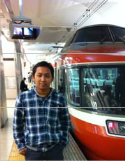
I am presently working at the Public Communication Center, Ministry of Public Works, Jakarta and my task is to provide information to the public performance such as road service, irrigation, human settlement and spatial planning. Through my work, I got interested in public private partnership in toll road development owing to the fact that the projects are a hot issue for the public as well as the press because they have been delayed for many years without implementation.
Three years ago, I was given an opportunity to study at graduate schools in Indonesia and Japan under the linkage double degree master program. I spent my first year at Master Program of Economic Planning and Development, Padjajaran University, Indonesia. And now, I am studying at International Cooperation Studies, Takushoku University. At both universities, I decided to do research on toll road development in Indonesia.
The toll road development in Indonesia has been taking place under public private partnership scheme to accelerate economic growth and competitiveness in global economy. For this reason, the government planned 1,600 km new toll road development involving private participation for 2005-2009 on top of then existing 608 km toll road. Unfortunately until 2011, only 156 km out of 1,600 km toll road has been constructed and in operation while the rest is still in the stage of land acquisition process. All the stakeholders concerned; the government, the private sector, the road user and the landowner are disappointed with this situation in spite of the fact that 23 concession agreements were signed 6 years ago for 900 km toll road. The delay must have been caused by many factors. One of the most serious factors is the lack of government fund for land clearance. I have observes there are many other problems in toll road development in Indonesia. This is why I chose this theme as my thesis topic. In my thesis I try to identify factors which contribute to delay of implementation of PPP toll road projects and find out ways and means to solve them. I hope my understanding about PPP can be useful when I get involved in the PPP project scheme in my office in the future. I am sure my knowledge would help to promote communication between the government and the public for the successful implementation of PPP project.
Through my studies, I am very much impressed by the Japanese experiences of rapid and successful growth of toll road development. I take the privilege of learning Japanese secrets of toll road development. There are ample case studies available such as national expressway, urban expressway, regional arterial roads, bridges and tunnels which exceed 10,000 km. The Japanese experiences in toll road development can be important inputs for my thesis as well as toll road development in Indonesia.
Gustav Sugiantoro (Mr.)
Linkage Double Degree Master Program
Padjajaran University – Takushoku University
Information of JSCE Annual Meeting
Annual Meeting & 67th Annual Conference
Date: September 5-7, 2012 Venue: Nagoya University, Nagoya, Aichi, Japan
International Program
Date: September 5-6, 2012 Venue: ES Hall, Nagoya University, Nagoya, Aichi, Japan Overall Program: Day 1: September 5, 2012 1) Roundtable Meeting-Part 1 Topic: Multilateral Cooperation/ Collaboration in Developing Disaster-Resilient Infrastructures 2) International Summer Symposium Day 2: September 6, 2012 1) Roundtable Meeting-Part 2 Topic: Multilateral Cooperation/ Collaboration in Developing Disaster-Resilient Infrastructures (continued Day-1) 2) International Summer Symposium
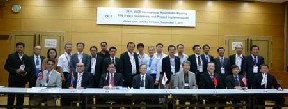 Photo International Program in 2011
Photo International Program in 2011
The 14th International Summer Symposium, JSCE
in conjunction with JSCE 67th Annual Conference
Date: Sept 5-6, 2012 Place: Nagoya University, Nagoya, Aichi, Japan
Day 1: September 5, 2012 AM: Invited Lectures ・History of Japanese civil engineering ・Construction projects in Japan ・Disaster management PM: Presentation of Papers Day 2: September 6, 2012 AM: Presentation of Papers *For more information: http://www.jsce-int.org/.
Information
Introduction of Journal of JSCE
The Japan Society of Civil Engineers launches Journal of JSCE to provide access to rigorously refereed innovative research and practical papers, across the fields of civil engineering.
The Society has been publishing domestic Journal since 1944. Language used in papers published in the existing Journal is mainly Japanese, but some are written in the other languages, such as English, German. To increase the international appeal of the Journal, the Society decided to launch an International Journal and first issue will be published in 2013 as online Journal.
If you have any interest, you can contact following website: http://committees.jsce.or.jp/jjsce/english/index-e
Event Calendar
6th CECAR (Civil Engineering Conference in the Asian Region)
Date: August 20-22, 2013 Venue: Hotel Borobudur, Jakarta, Indonesia Website: http://www.cecar6.com/ Call for Papers: Important Dates: •Deadline of Abstract Submission: September 3, 2012 •Abstract Acceptance Notification: November 2, 2012 •Deadline of Full Paper Submission: 14 January 2013 •Full Paper Acceptance Notification: 15 March 2013 •Deadline of Revised Full Paper Submission: 15 April 2013
AIJ-JSCE Joint International Workshop on Natural Disaster Mitigation
Date: September 13, 2012 Time: 9:00-12:30 Venue: Room 205, ES Building, Nagoya University, Nagoya, Aichi, Japan Fee: Free Language: English Website: http://www.jsce-int.org/
Send your comments and suggestions to: iad@jsce.or.jp JSCE Website: http://www.jsce-int.org
Editorial Board: Information Subcommittee,
International Activities Committee, JSCE
Chief Editor: Dr. Satoru KOBAYAKAWA
Editor in Charge: Dr. Shinichi TAKEDA

